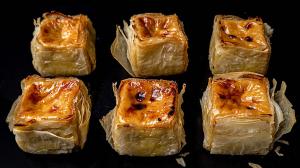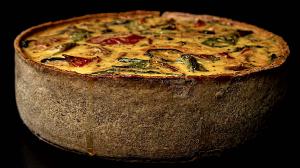It’s an early morning reward, a breakfast pastry just for you. You’ve gotten up and readied yourself to brave the new day. It’s a sweetened milk & egg dish in its own crispy carrying case, still slightly warm and ever-so-gently spiced, to rock your heart and soul and body as you walk yourself to work or maybe a stroll because you’re on vacation or just some early shopping as you head back home with a few extra of these pastries for your loved ones. Ideally, you would happen to be in some Mediterranean land and enjoying its heavenly climate, not too far from the sea where you can hear the waves slapping against the sand, back and forth incesantly, frothing up at the edges where it caresses the seaweed. You gaze up at the clear blue transparent skies, a few birds flit by and chirp away, a bumblebee lazily buzzing as it sips the nectar from one flower bloom to the next and a few street vendors washing their stoops and sidewalks as they set up their stalls and wooden painted stools. The fresh aroma of bread from the neighborhood bakery (where you just bought this little custard tartlet) is wafting through the street, as a dog laying around in the shade of a tree, pokes up his muzzle as you walk by and lays its lolling head back down reassuringly, because it knows that it's going to a good day. All you need to complete the image is to sit down somewhere nice and have a cold 'frappé' iced coffee.
This is obviously a memory … but sometimes preparing food, whether cooking & baking or just assembling it, can transport me to another time and place of my life.
CUSTARD can be made patiently with some elbow grease and can be an ideally minimalistic mixture of eggs, sometimes just the yolks (but I prefer whole eggs because I often forget the whites in the refrigerator) and milk with the addition of very heavy cream (but I prefer evaporated milk and 30% heavy cream) and sugar with some personally chosen flavorings. I said ideally. Flour or cornstarch is often added as a thickener to save time and speed up the process, but I haven’t used any because it’s not necessary, if you’re not rushed and if you don’t feel like forcing the whole thing through a fine-meshed sieve to get rid of lumps. Mine is lump-free, creamy and smooth because of this lack of flour and cornstarch and because I took my time, almost meditating on its slow thickening as I stirred and whisked …
Many countries have their own versions of custard pies. If we focus on Europe, there are those in Greece called “galaktoboureko” and “bougatsa” and “galatopita”, Portugal’s “pastel de nata”, Spain’s “natillas” and “tarta a la crema” and “flans”, also French, England’s “custard tart” and of course many variations, made with puff pastry or a sweetened shortcrust or even nothing at all, sometimes with whipped cream, citrus zests, powdered sugar and powdered cinnamon coatings and the list goes on. The textures can differ from being definitely thick and creamy, if cooked very slowly at lower heat, or a more scrambled effect, when it’s rushed and cooked at higher heat. They’re all SO GOOD.
My version is simple in its flavors and creamy in its texture because it’s all about the patience required (and only if you can afford it) for the slow thickening of the sugar, egg, milk and cream mixture and the slow low-temperature baking, and yet it is complex in its assembly to make those cube-shaped and delicately crunchy filo shells, becoming a pastry that is easily hand-held as you walk the streets and (if you’re lucky) noticing everything around you while taking the time to smell those roses .(and perhaps orange blossoms and jasmin flowers too) . . . :)
























